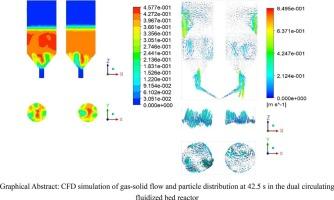双循环流化床反应器太阳能化学循环燃烧数值模拟
IF 4.6
2区 工程技术
Q2 ENGINEERING, CHEMICAL
引用次数: 0
摘要
本文建立了太阳能双循环流化床反应器中流动与传热耦合过程的理论模型。采用欧拉-欧拉方法对气固两相流动进行了数学模拟,并考虑了系统内的化学反应。采用计算流体力学(CFD)模拟了反应器内太阳能辅助流动、传热和化学反应的综合过程。分析了颗粒和气体产物的分布规律、两个反应器之间的传热特性以及颗粒在固体循环回路中的瞬态行为。比较了不同太阳辐射通量和进气速度对反应器流动和传热耦合特性的影响。结果表明:颗粒体积分数和颗粒速度随辐射通量和入口速度的增大而增大;气体产物浓度也随着反应的进行而增加,并且在颗粒积聚较大的区域观察到较高的固体颗粒温度。本文章由计算机程序翻译,如有差异,请以英文原文为准。

Numerical simulation of chemical looping combustion applying solar energy to a dual circulating fluidized bed reactor
This study presents a theoretical model for coupled flow and heat transfer processes in a dual circulating fluidized bed reactor for solar energy applications. A mathematical simulation of gas-solid two-phase flow is conducted using the Eulerian-Eulerian method, incorporating chemical reactions within the system. Computational fluid dynamics (CFD) is employed to simulate the integrated process of solar-assisted flow, heat transfer, and chemical reactions inside the reactor. The distribution patterns of particles and gas products, the heat transfer characteristics between the two reactors, and the transient behavior of particles in the solid recirculation loop are analyzed. The effects of varying solar radiation flux and air inlet velocity on the reactor's coupled flow and heat transfer characteristics are compared. Results indicate that particle volume fraction and particle velocity in the recirculation loop increase with higher radiation flux or air inlet velocity. Gas product concentrations also increase as the reaction proceeds, and higher solid particle temperatures are observed in regions with greater particle accumulation.
求助全文
通过发布文献求助,成功后即可免费获取论文全文。
去求助
来源期刊

Powder Technology
工程技术-工程:化工
CiteScore
9.90
自引率
15.40%
发文量
1047
审稿时长
46 days
期刊介绍:
Powder Technology is an International Journal on the Science and Technology of Wet and Dry Particulate Systems. Powder Technology publishes papers on all aspects of the formation of particles and their characterisation and on the study of systems containing particulate solids. No limitation is imposed on the size of the particles, which may range from nanometre scale, as in pigments or aerosols, to that of mined or quarried materials. The following list of topics is not intended to be comprehensive, but rather to indicate typical subjects which fall within the scope of the journal's interests:
Formation and synthesis of particles by precipitation and other methods.
Modification of particles by agglomeration, coating, comminution and attrition.
Characterisation of the size, shape, surface area, pore structure and strength of particles and agglomerates (including the origins and effects of inter particle forces).
Packing, failure, flow and permeability of assemblies of particles.
Particle-particle interactions and suspension rheology.
Handling and processing operations such as slurry flow, fluidization, pneumatic conveying.
Interactions between particles and their environment, including delivery of particulate products to the body.
Applications of particle technology in production of pharmaceuticals, chemicals, foods, pigments, structural, and functional materials and in environmental and energy related matters.
For materials-oriented contributions we are looking for articles revealing the effect of particle/powder characteristics (size, morphology and composition, in that order) on material performance or functionality and, ideally, comparison to any industrial standard.
 求助内容:
求助内容: 应助结果提醒方式:
应助结果提醒方式:


